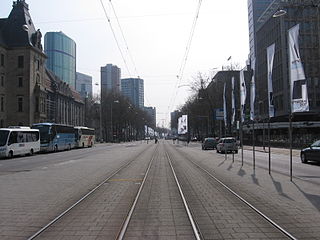
Rotterdam is the second-largest city in the Netherlands after the national capital of Amsterdam. It is in the province of South Holland, part of the North Sea mouth of the Rhine–Meuse–Scheldt delta, via the "New Meuse" inland shipping channel, dug to connect to the Meuse at first and now to the Rhine.

The Hague is a city and municipality of the Netherlands, situated on the west coast facing the North Sea. The Hague is the capital of the province of South Holland, and the city hosts both the International Court of Justice and the International Criminal Court. The Hague is the country's administrative centre and its seat of government, and while the official capital of the Netherlands is Amsterdam, The Hague has been described as the country's de facto capital.

Henri "Hans" van den Broek is a retired Dutch politician and diplomat of the defunct Catholic People's Party (KVP) and later the Christian Democratic Appeal (CDA) party and jurist who served as European Commissioner from 6 January 1993 until 16 September 1999.
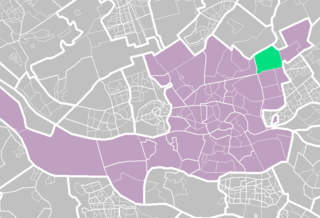
Ommoord is a neighbourhood in the former borough Prins Alexander, part of the municipality of Rotterdam, South Holland, the Netherlands. Ommoord is surrounded by the neighbourhoods Zevenkamp, Het Lage Land and Terbregge. It has around 25.000 inhabitants across 12.500 households. Ommoord shares postal codes 3068 and 3069 with Zevenkamp.

Johannes Hendrik ("Jo") van den Broek, was a Dutch architect influential in the rebuilding of Rotterdam after World War II.
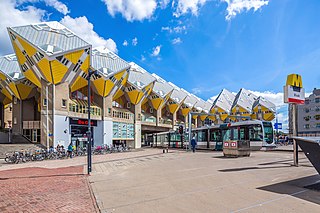
Cube houses are a set of innovative houses built in Helmond and Rotterdam in the Netherlands, designed by architect Piet Blom and based on the concept of "living as an urban roof": high density housing with sufficient space on the ground level, since its main purpose is to optimise the space inside. Blom tilted the cube of a conventional house corner upwards, and rested it upon a hexagon-shaped pylon. His design represents a village within a city, where each house represents a tree, and all the houses together, a forest. The central idea of the cube houses around the world is mainly optimizing the space, as a house, to a better distribution of the rooms inside.

The Rotterdam Metro is a rapid transit system operated in Rotterdam, Netherlands and surrounding municipalities by RET. The first line, called Noord – Zuidlijn opened in 1968 and ran from Centraal Station to Zuidplein, crossing the river Nieuwe Maas in a tunnel. It was the first metro system to open in the Netherlands. At the time it was also one of the shortest metro lines in the world with a length of only 5.9 km (3.7 mi).

The Lijnbaan is the main shopping street of Rotterdam. It was opened in 1953, as the main pedestrian street in the new shopping district, after the old shopping district was completely destroyed during the bombing of Rotterdam by the German Luftwaffe. It was designed by the firm Van den Broek & Bakema led by architects Jo van den Broek and Jacob B. Bakema. It was the first purpose-built pedestrian street in Europe.
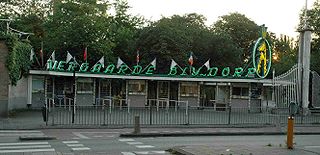
Diergaarde Blijdorp, officially Rotterdam Zoo, is a zoo located in the northwestern part of Rotterdam. It is one of the oldest zoos in the Netherlands, and has been operated by the Stichting Koninklijke Rotterdamse Diergaarde. Divided into several zoogeographic regions, the 26-hectare (64.25-acre) Blijdorp Zoo boasts 562 species. It also has a shop, multiple cafes, and an information centre.

Feijenoord is a district in Rotterdam and is located south of the Nieuwe Maas. As of 1 January 2004 there were 72,320 inhabitants. The area is 6.44 km². It is not the current home of the city's main football club, Feyenoord, which is now in the neighbouring township of IJsselmonde.

Katendrecht is a neighbourhood of Rotterdam, on the south bank of the Nieuwe Maas. It is located between the Rijnhaven and the Maashaven. Katendrecht was a separate municipality from 1817 to 1874, when it merged with Charlois.

Overschie is a neighborhood of Rotterdam, Netherlands, formerly a separate village with its own municipality.

The former Van Nelle Factory on the Schie in Rotterdam, is considered a prime example of the International Style based upon constructivist architecture. It has been a designated UNESCO World Heritage Site since 2014. Soon after it was built, prominent architects described the factory as "the most beautiful spectacle of the modern age" and "a poem in steel and glass".

The Our Lady of the Holy Rosary Church, also known as the Provenierskerk or Proveniershuis Singelkerk was a Roman Catholic church on the Proveniershuis canal in Rotterdam.
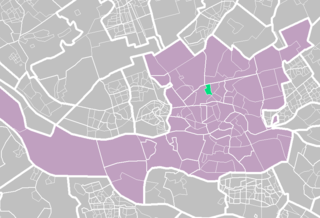
Bergpolder is a neighborhood of Rotterdam, Netherlands in Rotterdam-Noord. Since November 5, 2014, the district is part of the protected historic area "Rijksbeschermd gezicht Blijdorp/Bergpolder".

Kleiwegkwartier is a neighbourhood quarter in Rotterdam, Netherlands. It is in the southern part of Hillegersberg with origins dating from the early 1600s.

Spangen is a neighborhood of Rotterdam, Netherlands.

Stadsdriehoek is a neighborhood at the center of Rotterdam, Netherlands. The name Stadsdriehoek refers to the historical triangular form of the city of Rotterdam, which was bordered by the Coolsingel and the Schiedamsevest to the west, the Goudsevest to the northeast, and by the Nieuwe Maas to the south.

Michiel Brinkman (1873–1925) was a Dutch architect and the father of Johannes Brinkman the exponent of Nieuwe Bouwen, modern architecture in the Netherlands. Michiel Brinkman is notable for his Justus van Effen housing block complex in Spangen, which is a Rijksmonument, built in 1922. it incorporates 3m wide connecting terraces on the third floor, known in Dutch as Bovenstraten, and in English as 'Streets in the sky'.



















